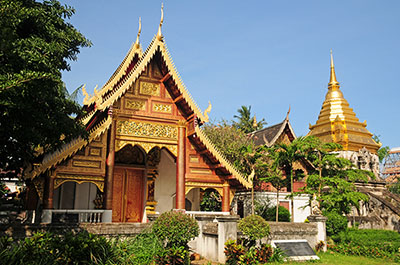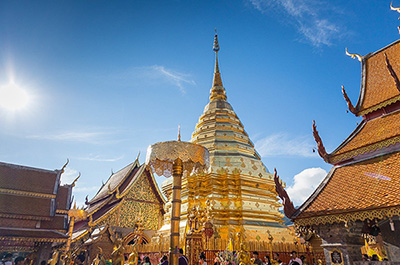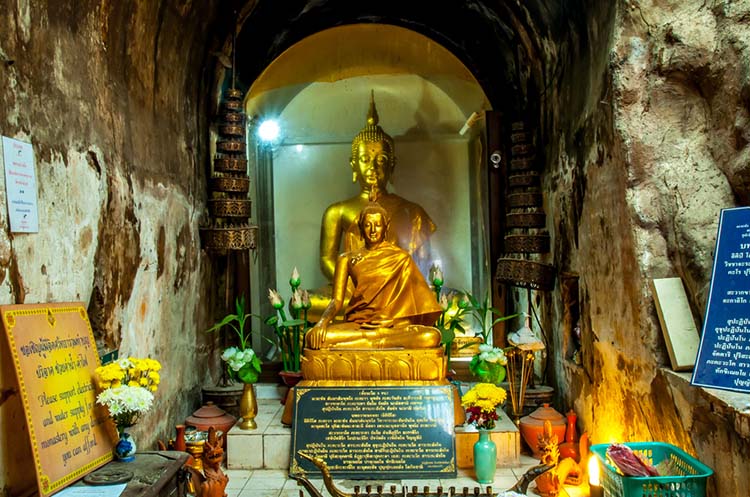
Wat Umong
“The Tunnel Temple”
Chiang Mai
Among the hundreds of Buddhist temples in Chiang Mai, the Wat Umong or “Tunnel temple” is unique because of its location in the forest and its system of tunnels. The serene and peaceful atmosphere at the 13th century forest temple not far from Doi Suthep mountain and Doi Suthep temple provides a welcome change from the much visited sites in Chiang Mai.
The temple’s full name is Wat Umong Suan Phutthatham, which translates to “Temple of the tunnels and Buddha Dhamma garden”.
Tunnels containing Buddha images
A number of tunnels dug out of a mound contains shrines with Buddha images, where devotees can pay their respect to the Buddha.
Good place for meditation
The large, shady temple grounds are often filled with the sounds of monks’ chanting. The temple’s setting in a forested area with a natural lake makes the Wat Umong an excellent place for meditation. The meditation center hosts meditation classes and Dhamma talks.
History of the Wat Umong
The Wat Umong was founded at the end of the 13th century by King Mengrai, first King of the Lanna Kingdom and founder Chiang Mai.
According to local legend, the King regularly consulted a monk who lived at the Wat Umong Maha Thera Chan, a temple located within the old city walls of Chiang Mai. The monk named Thera Chan used a tunnel to meditate in peace and quiet.
When the city of Chiang Mai grew bigger and more crowded, the monk found it more and more difficult to meditate. King Mengrai wanted to accommodate the monk and ordered a number of tunnels dug out in a man made mound outside the city, in a forested area bordering Doi Suthep mountain. The tunnels were lined with brick walls, plastered and Buddhist murals were painted. Shrines with images of the Buddha were added, giving the monk a new place to meditate in peace and quiet.
The temple was abandoned during the 15th century. Only in 1948 the temple was restored and one year later reopened as a center for meditation and Buddhist teachings. Today the Wat Umong is an active temple with resident monks. The ancient tunnels have been restored. Unfortunately, most of the murals have disappeared.
Large bell shaped chedi
On top of the mound is a large, circular bell shaped chedi. The Lanna style chedi has recently been restored. Near the chedi is a black image of a very thin fasting Buddha in the ascetic style.
The kuti, the monks living quarters, are scattered in the forest.
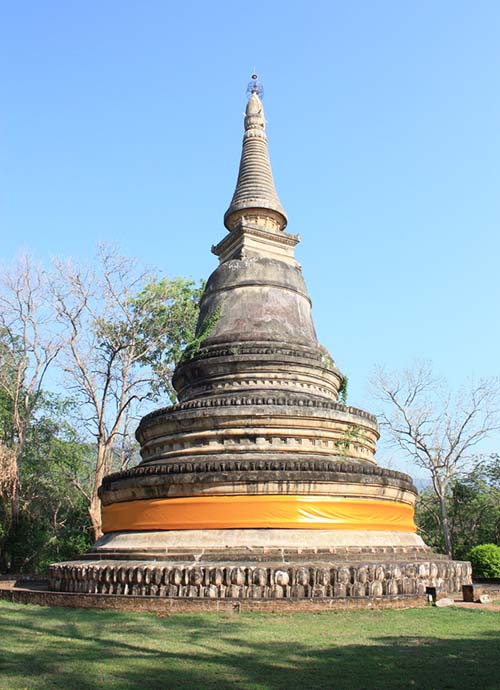
Copy of an Ashoka pillar
On the temple grounds is a copy of an Ashoka pillar dating back to the founding of the temple in the 13th century. On top of the pillar are four lions and a Dhamma wheel over them.
In the 3rd century BC, the Indian King Ashoka send out monks across South and South East Asia, and even as far as Europe to spread Buddhism. A large number of inscribed pillars were erected across India and surrounding countries, some of which still remain today. The pillars are inscribed with details about the spread of Buddhism.
Damaged Buddha images
Along the trail around the mound is a collection of damaged Buddha images scattered on the grounds between the trees. The images, of some of which only the head is left were brought over from several other temples.
Pond with catfish
In the forest on the temple grounds is a pond with catfish, ducks and turtles waiting to be fed. Food can be bought from one of the vendors at the grounds.
Signs hung from trees with Buddhist proverbs
Along the path through the forest towards the lake are signs with Buddhist proverbs hung from trees, in Thai and English. Among them are:
“Love is Devine, lust is devil”
“Today is better than two tomorrows”
“Nothing is permanent. Things go in and go out”
“All things arise, exist and expire”
“The thing that is liked or disliked just appears, exists for a moment and expires”
“Detachment is a way to relax”
Meditation and Dhamma talks
In 1948 after the restorations had been completed, the Wat Umong reopened as a center for meditation and Buddhist teachings. The temple is also known as Suan Buddha Dhamma, or “Garden of Buddha’s Teachings”.
Every Sunday between 3 and 6 pm, Dhamma talks are held in English at the Chinese pavilion close to the pond. Monks talk about Buddhism and there is an opportunity to ask questions. The Wat Umong meditation center practices the Anapanasati meditation method, which concentrates on breathing. If you are interested in joining meditation sessions, inquire first to make sure the sessions are in the English language.
Meditation retreats
For more information about meditation and a list of retreats and temples in Thailand that teach Vipassana or Samatha meditation, read meditation retreats in Thailand.
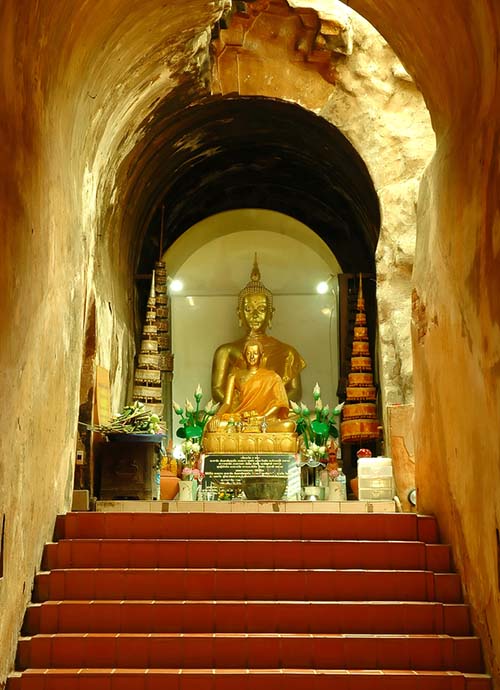
Location
The Wat Umong is located just West of Chiang Mai city not far from Doi Suthep mountain and Doi Suthep temple. The temple is found about 1,500 meters South of Suthep road, just West of the Chiang Mai outer ring road.
How to get to the Wat Umong
You can get there by private taxi, tuk tuk, songthaew or samlor. Since the temple is a bit out of the way, it can be difficult to find a ride for the return trip, so it would be advisable to book a round trip and have the driver wait.
The most comfortable way to get there is by private taxi. Most hotels can book one for you, the fare is about 250 Thai Baht one way.
Another way is by songthaew, a converted pick up truck with benches in the back. Flag down a songthaew that does not follow a fixed route (usually they are red), and negotiate a price with the driver. Fare is about 70 Baht per person, one way. A tuk tuk or samlor bicycle taxi (very slow) taking two people should cost between 100 and 150 Baht, one way.
Opening hours
The temple opens daily from 6 am until 5 pm.
Entrance fee
Admission is free.
